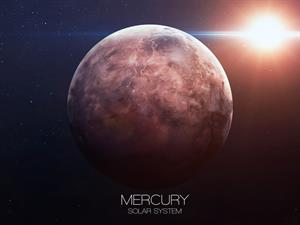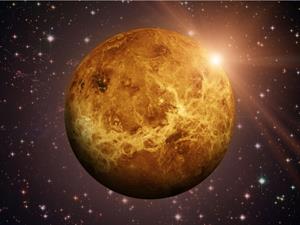
PUMPA - SMART LEARNING
எங்கள் ஆசிரியர்களுடன் 1-ஆன்-1 ஆலோசனை நேரத்தைப் பெறுங்கள். டாப்பர் ஆவதற்கு நாங்கள் பயிற்சி அளிப்போம்
Book Free DemoMercury:
Mercury is the nearest planet to the Sun. It is the smallest planet without any satellite of its own. It is difficult to observe this planet since it is hidden in the glare of the Sun. But still, it can be observed near the horizon just before sunrise or after sunset through a telescope. This rocky planet looks grey in colour.

Mercury
The rotation period is \(58.65\ days\), and the period of revolution is \(88\ days\). Mercury is considered the fastest planet in the solar system since it revolves around the Sun in \(88\ days\).
Venus:
Venus is the nearest neighbour planet of Earth which does not have any satellite of its own. Venus is said to be the 'Twin of the Earth' due to their similarities in size and surface composition of Earth. It appears yellowish in colour.
Venus
Rotation of the planet:
All the other planets rotate in the anti-clockwise direction from west to east. But, Venus rotates in the clockwise direction, i.e., from east to west. This planet completes its rotation in \(243\ days\), and the period of revolution is \(225\ days\).
All the other planets rotate in the anti-clockwise direction from west to east. But, Venus rotates in the clockwise direction, i.e., from east to west. This planet completes its rotation in \(243\ days\), and the period of revolution is \(225\ days\).
Hottest planet of the solar system:
Venus is the hottest planet in the solar system because it has a thick atmosphere composed of carbon-di-oxide and clouds of sulphuric acid. These gases in the atmosphere trap the heat produced by the Sunlight falling on the planet and retain it inside. This makes the planet hot.
Appearance in the sky:
Due to the planet's thick atmosphere, the light falling on the clouds gets reflected in the sky and appears as the brightest planet. This brightest planet appears in the eastern or the western sky. Hence, it is also called a morning star or an evening star.
Due to the planet's thick atmosphere, the light falling on the clouds gets reflected in the sky and appears as the brightest planet. This brightest planet appears in the eastern or the western sky. Hence, it is also called a morning star or an evening star.